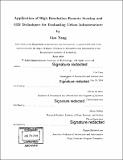| dc.contributor.advisor | Olivier de Weck and Afreen Siddiqi. | en_US |
| dc.contributor.author | Yang, Lisa, S. M. Massachusetts Institute of Technology | en_US |
| dc.contributor.other | Massachusetts Institute of Technology. Department of Aeronautics and Astronautics. | en_US |
| dc.date.accessioned | 2019-02-05T15:57:12Z | |
| dc.date.available | 2019-02-05T15:57:12Z | |
| dc.date.copyright | 2018 | en_US |
| dc.date.issued | 2018 | en_US |
| dc.identifier.uri | http://hdl.handle.net/1721.1/120199 | |
| dc.description | Thesis: S.M., Massachusetts Institute of Technology, Department of Aeronautics and Astronautics, 2018. | en_US |
| dc.description | Cataloged from PDF version of thesis. | en_US |
| dc.description | Includes bibliographical references (pages 71-76). | en_US |
| dc.description.abstract | City planners use information about a city's vegetation, urban morphology, and land-use to make decisions. The availability of high-resolution imagery is now expanding the type of information that can be used for planning as well as for understanding urbanization dynamics. This research uses very high resolution orthoimagery with three bands to obtain information about specific urban structures, such as roads and pavement, buildings, and solar panels, as well as non-impervious surface areas of vegetation and water. The maximum likelihood classifier (MLC) was used for the analysis of the images, and geographical information system (GIS) techniques were used to extract features. Two case studies were done for the cities of Phoenix, Arizona for the years 2004, 2006, 2008, and 2012 and for Seattle, Washington for 2002, 2005, and 2009. Results indicate that the area of buildings and the number buildings with solar panels have increased while the area of vegetation has increased for both Phoenix.and Seattle. The area of water has decreased for Seattle while the increase in water for Phoenix could suggest that more people are installing pools. The length of roads increases slightly for Seattle but decreases for Phoenix, a potential result of parking lots being converted into parking garages. The quantitative trends in the infrastructure were then compared to power law relationships between population and urban growing and scaling indicators. | en_US |
| dc.description.statementofresponsibility | by Lisa Yang. | en_US |
| dc.format.extent | 88 pages | en_US |
| dc.language.iso | eng | en_US |
| dc.publisher | Massachusetts Institute of Technology | en_US |
| dc.rights | MIT theses are protected by copyright. They may be viewed, downloaded, or printed from this source but further reproduction or distribution in any format is prohibited without written permission. | en_US |
| dc.rights.uri | http://dspace.mit.edu/handle/1721.1/7582 | en_US |
| dc.subject | Aeronautics and Astronautics. | en_US |
| dc.title | Application of high resolution remote sensing and GIS techniques for evaluating urban infrastructure | en_US |
| dc.type | Thesis | en_US |
| dc.description.degree | S.M. | en_US |
| dc.contributor.department | Massachusetts Institute of Technology. Department of Aeronautics and Astronautics | |
| dc.identifier.oclc | 1082522762 | en_US |
